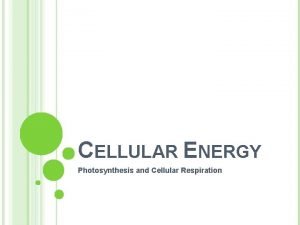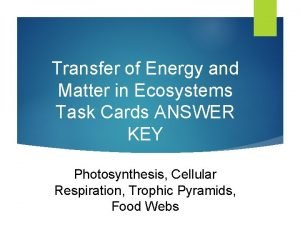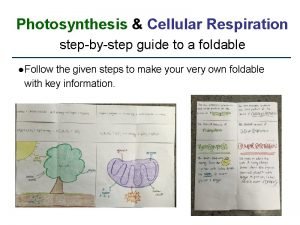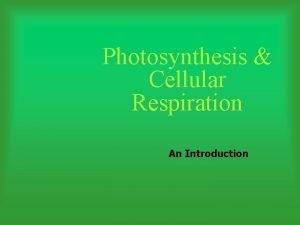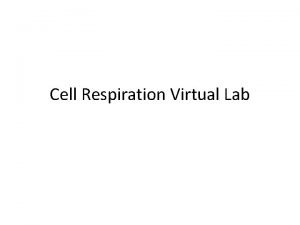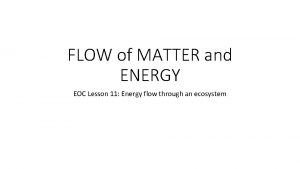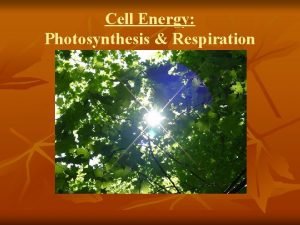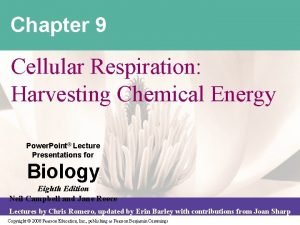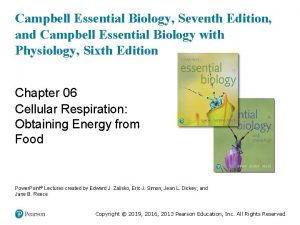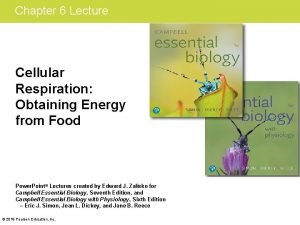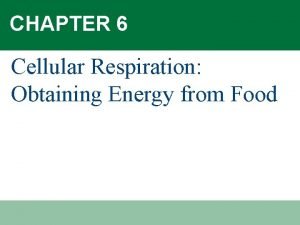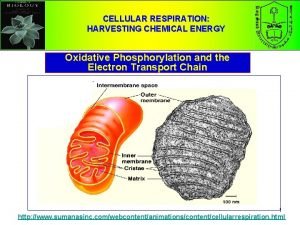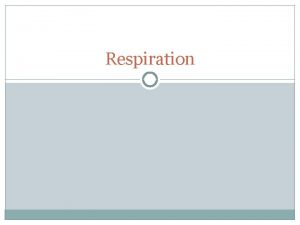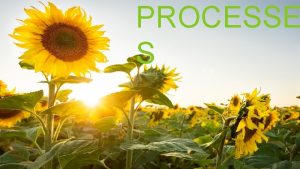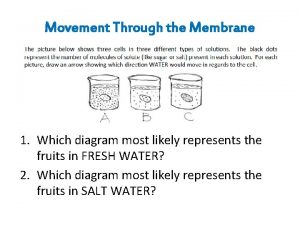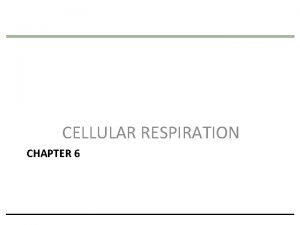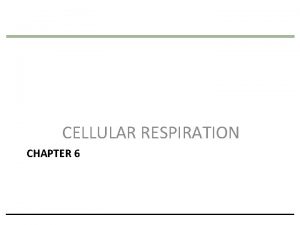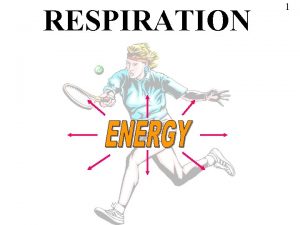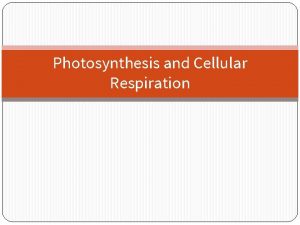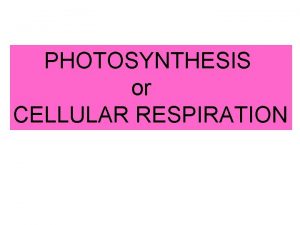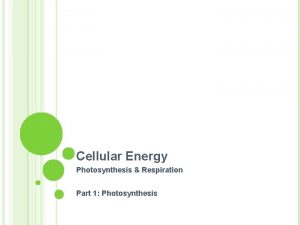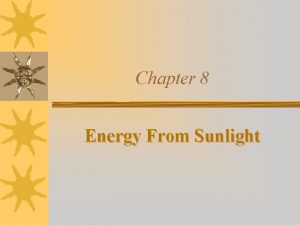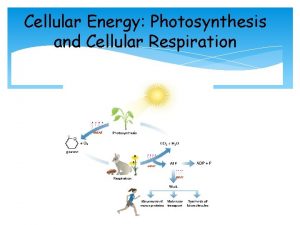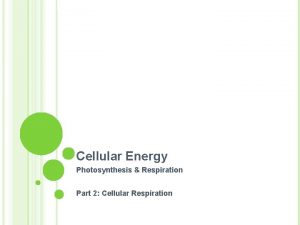CELLULAR RESPIRATION CHAPTER 9 Sunlight energy ECOSYSTEM Photosynthesis































- Slides: 31

CELLULAR RESPIRATION CHAPTER 9

Sunlight energy ECOSYSTEM Photosynthesis in chloroplasts CO 2 Glucose H 2 O O 2 Cellular respiration in mitochondria ATP (for cellular work) Heat energy

Cellular Respiration Banks Energy in ATP Molecules Cellular respiration transfers energy from the bonds of glucose and stores it in ATP Cellular respiration produces ~38 ATP/glucose molecule C 6 H 12 O 6 Glucose + 6 O 2 Oxygen 6 CO 2 Carbon dioxide + 6 H 2 O Water + ATPs Energy Other foods (organic molecules) can be used as a source of energy as well

Cellular Respiration is a Redox Process, As is Photosynthesis Loss of hydrogen atoms (oxidation) C 6 H 12 O 6 + 6 O 2 6 CO 2 + 6 H 2 O + Energy (ATP) Glucose Gain of hydrogen atoms (reduction)

Enzymes are Necessary to Oxidize Glucose and Other Foods The enzyme that removes hydrogens from organic molecule is called dehydrogenase Oxidation Dehydrogenase NAD+ + 2 H 2 H+ + 2 e – Reduction + NADH + H (carries 2 electrons)

Cells Tap Energy From Electrons “falling” from Organic Fuels to Oxygen – Dehydrogenase requires a coenzyme called NAD+ (nicotinamide adenine dinucleotide) to carry e– FAD functions like NAD+ accepting e-, becoming NADH and FADH 2 – They “carry” e- from glucose to the electron transport chain or ETC located on the cristae of the mitochondria Copyright © 2009 Pearson Education, Inc.

Cells Tap Energy From Electrons “falling” From Organic Fuels to Oxygen When the bonds of glucose are broken, electrons are ultimately transferred to oxygen Oxygen is electronegative, and thus pulls e- towards it As electrons move from glucose to oxygen, energy is released in small amounts, stored in a gradient that is used to synthesize ATP

NADH NAD+ ATP + 2 e– Controlled release of energy for synthesis of ATP H+ El ec tro nt ch ra ain ns po rt 2 e– H+ H 2 O 1 2 O 2

Breathing Supplies Oxygen to Our Cells For Use in Cellular Respiration and Removes Carbon Dioxide Breathing and cellular respiration are closely related – Breathing is necessary for the exchange of CO 2 produced during cellular respiration for atmospheric O 2

O 2 Breathing CO 2 Lungs CO 2 Bloodstream Muscle cells carrying out Cellular Respiration Glucose + O 2 CO 2 + H 2 O + ATP O 2

STAGES OF CELLULAR RESPIRATION

Cellular Respiration Occurs in Three Main Stages Stage 1: Glycolysis – Location: cytoplasm – Purpose: to split glucose – What happens: A single molecule of glucose is enzymatically cut in half through a series of steps producing two molecules of pyruvate – Redox reactions produce NADH – Substrate-level phosphorylation to produces ATP – Products/glucose : 2 pyruvate, 2 NADH, 2 ATP

ENERGY INVESTMENT PHASE Glucose ATP Steps 1 – 3 A fuel molecule is energized, using ATP. 1 ADP P Glucose-6 -phosphate P Fructose-1, 6 -bisphosphate 2 ATP 3 ADP P Step 4 A six-carbon intermediate splits Into two three-carbon intermediates. 4 P Step 5 A redox reaction generates NADH. Glyceraldehyde-3 -phosphate (G 3 P) P NAD+ 5 P NADH 5 NADH + H+ ENERGY PAYOFF PHASE P + H+ P P ADP P P 1, 3 -Bisphoglycerate ADP 6 6 ATP P P 3 -Phosphoglycerate 7 7 P Steps 6 – 9 ATP and pyruvate are produced. P 2 -Phosphoglycerate 8 H 2 O P P ADP Phosphoenolpyruvate (PEP) ADP 9 ATP 8 H 2 O 9 ATP Pyruvate

Substrate-level Phosphorylation § Substrate-level phosphorylation is the enzymatic transfer of a phosphate group from a substrate molecule to ADP, forming ATP Enzyme ADP ATP P Substrate P Product

Pyruvate is Chemically Groomed for The Kreb’s Cycle Grooming Step Location: mitochondrial matrix Purpose: to prepare pyruvate for entry into the Kreb’s cycle What Happens: Occurs in three steps – 1. The removal of a carboxyl group (decarboxylation), from pyruvate (first release of CO 2) – 2. Oxidization of the remaining 2 -carbon compound forming acetate – 3. Binding of Coenzyme A to the 2 -carbon acetate forming acetyl coenzyme A Products/glucose: 2 CO 2 , 2 NADH, 2 Acetyl Co. A

Pyruvate is Chemically Groomed for The Kreb’s Cycle NADH H+ NAD+ 2 Co. A Pyruvate 1 CO 2 3 Coenzyme A Acetyl coenzyme A

Cellular Respiration Occurs in Three Main Stages Stage 2: The Kreb’s Cycle (Citric Acid Cycle) – Location: mitochondrial matrix – Purpose: final oxidation of glucose fragments into CO 2 and formation of electron carriers – What Happens: A 2 -C acetate combines with 4 -C oxaloacetate forming 6 -C citrate. – Four redox reactions to produce NADH and FADH 2 – Substrate-level phosphorylation to produces ATP – 4 -C Oxaloacetate is regenerated to bind acetate and start the cycle again – Products/glucose : 4 CO 2, 6 NADH, 2 FADH 2 , 2 ATP,

Co. A Acetyl Co. A 2 carbons enter cycle Oxaloacetate 1 Citrate NADH + H+ NAD+ 5 NAD+ 2 NADH + H+ CITRIC ACID CYCLE CO 2 leaves cycle Malate ADP P FADH 2 4 ATP FAD Alpha-ketoglutarate 3 CO 2 leaves cycle Succinate NADH + H+ Step 1 Acetyl Co. A stokes the furnace. NAD+ Steps 2 – 3 NADH, ATP, and CO 2 are generated during redox reactions. Steps 4 – 5 Redox reactions generate FADH 2 and NADH.

Cellular Respiration Occurs in Three Main Stages Stage 3: Oxidative phosphorylation (the ETC) – Location: cristae of mitochondrion – Purpose: to generate a proton gradient that will be used to form ATP – What Happens: Electrons are supplied by NADH & FADH 2 , then – – shuttled through the ETC. As e- are transported from protein to protein, H+ are concentrated in the intermembrane space The potential energy of this proton gradient is used to make ATP by chemiosmosis The concentration gradient drives H+ through ATP synthases producing ATP The ETC + chemiosmosis = oxidative phosphorylation Products/glucose: 34 -38 ATP and H 2 O

Oxidative Phosphorylation Intermembrane space Protein complex of electron carriers H+ H+ Electron carrier H+ H+ ATP synthase Inner mitochondrial membrane FADH 2 Electron flow NADH Mitochondrial matrix FAD NAD+ H+ 1 2 O 2 + 2 H+ H+ H+ H 2 O Electron Transport Chain OXIDATIVE PHOSPHORYLATION ADP + P H+ Chemiosmosis ATP

OVERVIEW OF AEROBIC RESPIRATION Electron shuttle across membrane Cytoplasm 2 NADH Mitochondrion 2 NADH (or 2 FADH 2) 6 NADH 2 NADH GLYCOLYSIS Glucose 2 Pyruvate 2 Acetyl Co. A 2 ATP by substrate-level phosphorylation Maximum per glucose: CITRIC ACID CYCLE 2 ATP by substrate-level phosphorylation About 38 ATP 2 FADH 2 OXIDATIVE PHOSPHORYLATION (Electron Transport and Chemiosmosis) about 34 ATP by oxidative phosphorylation

Overview of Cellular Respiration

Fermentation Enables Cells to Produce ATP Without Oxygen Fermentation is an anaerobic energy-generating process – Location: cytoplasm – Purpose: to produce ATP in the absence of oxygen – What Happens? : Glycolysis, and regeneration of NAD+ – Pyruvate is an “electron sink, ” to accept electrons generated by redox reactions in glycolysis – Your muscle cells and certain bacteria can oxidize NADH through lactic acid fermentation Copyright © 2009 Pearson Education, Inc.

2 ADP 2 P Glycolysis 2 ATP GLYCOLYSIS Glucose 2 NAD+ 2 NADH Lactic Acid Fermentation 2 Pyruvate 2 NADH Steps to regenerate NAD+ 2 Lactate Lactic acid fermentation

Fermentation Enables Cells to Produce ATP Without Oxygen The baking and winemaking industry have used alcohol fermentation for thousands of years – Occurs in yeast cells (single-celled fungi) – Yeast convert pyruvate to CO 2 and ethanol while oxidizing NADH back to NAD+

2 ADP 2 P Glycolysis 2 ATP GLYCOLYSIS Glucose 2 NAD+ 2 NADH 2 Pyruvate 2 NADH Steps to regenerate NAD+ with a release of CO 2 2 CO 2 released 2 NAD+ 2 Ethanol Alcohol fermentation Alcohol Fermentation

INTERCONNECTIONS BETWEEN MOLECULAR BREAKDOWN AND SYNTHESIS

Cells Use Many Kinds of Organic Molecules as Fuel for Cellular Respiration Although glucose is considered the primary source of sugar for respiration and fermentation, three molecules can serve as substrates for generating ATP – Carbohydrates (disaccharides) – Proteins (after conversion to amino acids) – Fats

Food, such as peanuts Carbohydrates Fats Glycerol Sugars Proteins Fatty acids Amino groups Glucose G 3 P Pyruvate GLYCOLYSIS Acetyl Co. A ATP CITRIC ACID CYCLE OXIDATIVE PHOSPHORYLATION (Electron Transport and Chemiosmosis)

ATP needed to drive biosynthesis ATP CITRIC ACID CYCLE Acetyl Co. A GLUCOSE SYNTHESIS Pyruvate G 3 P Glucose Amino groups Amino acids Proteins Fatty acids Glycerol Fats Cells, tissues, organisms Sugars Carbohydrates

Cellular respiration generates has three stages oxidizes uses ATP produce some (a) C 6 H 12 O 6 energy for produces many (b) (d) to pull to electrons down (c) by process called uses H+ diffuse through ATP synthase uses (e) pumps H+ to create (f)
 The process of photosynthesis and cellular respiration
The process of photosynthesis and cellular respiration Photosynthesis formula
Photosynthesis formula Equation of cellular respiration
Equation of cellular respiration Function of cellular respiration
Function of cellular respiration Where does cellular respiration take place
Where does cellular respiration take place Photosynthesis and cellular respiration foldable
Photosynthesis and cellular respiration foldable Where does the oxygen that we breathe come from edpuzzle
Where does the oxygen that we breathe come from edpuzzle Photosynthesis and cellular respiration
Photosynthesis and cellular respiration Snails and elodea virtual lab
Snails and elodea virtual lab Photosynthesis and cellular respiration jeopardy
Photosynthesis and cellular respiration jeopardy Photosynthesis or cellular respiration
Photosynthesis or cellular respiration Cellular respiration harvesting chemical energy
Cellular respiration harvesting chemical energy Explain how amp stimulates cellular respiration
Explain how amp stimulates cellular respiration Chapter 9: cellular respiration: harvesting chemical energy
Chapter 9: cellular respiration: harvesting chemical energy Chapter 6 cell energy photosynthesis and respiration
Chapter 6 cell energy photosynthesis and respiration Inputs of glycolysis
Inputs of glycolysis Consumer
Consumer Cellular respiration obtaining energy from food
Cellular respiration obtaining energy from food Cellular respiration obtaining energy from food
Cellular respiration obtaining energy from food Phosphorelation
Phosphorelation Chapter 8 section 2: photosynthesis
Chapter 8 section 2: photosynthesis Chapter 8 section 3 cellular respiration continued
Chapter 8 section 3 cellular respiration continued Chapter 8 section 1: how organisms obtain energy
Chapter 8 section 1: how organisms obtain energy Cellular respiration redox
Cellular respiration redox What is the correct equation for cellular respiration?
What is the correct equation for cellular respiration? Chemiosmosis steps
Chemiosmosis steps Where is aerobic respiration located
Where is aerobic respiration located Fermentation definition biology
Fermentation definition biology Why is cellular respiration important
Why is cellular respiration important Chemical formula for cellular respiration
Chemical formula for cellular respiration Cellular respiration reactants
Cellular respiration reactants Photosynthesis recipe card
Photosynthesis recipe card



